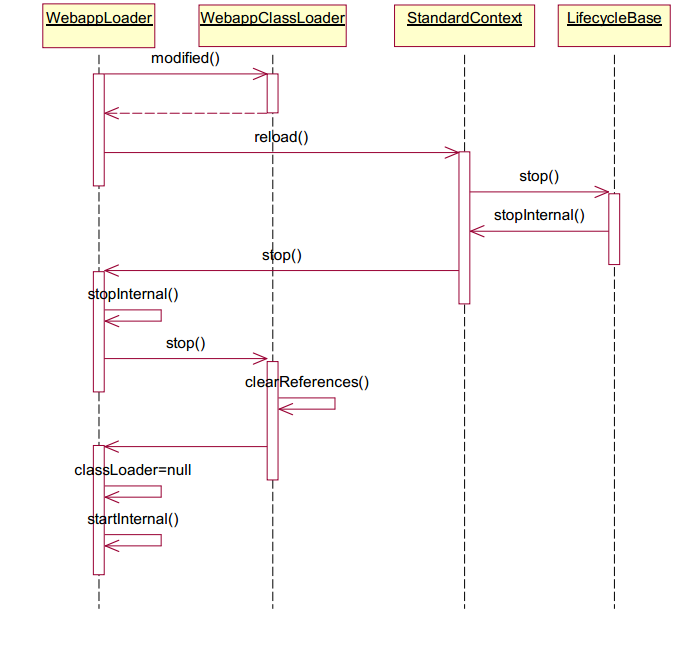tomcat源码解读(1)–tomcat热部署实现原理
tomcat的热部署实现原理:tomcat启动的时候会有启动一个线程每隔一段时间会去判断应用中加载的类是否发生变法(类总数的变化,类的修改),如果发生了变化就会把应用的启动的线程停止掉,清除引用,并且把加载该应用的WebappClassLoader设为null,然后创建一个新的WebappClassLoader来重新加载应用。 tomcat中热部署发现类变法之后要做的一系列停止工作的时序图如下:

上面时序图中只把关键的流转步骤画出来了,还有一些细节的处理没有完全画出来,这部分代码的继承的结构还是比较复杂的,debug上面的流程的时候,各种跳转。先解释一下上面的时序图,这个时序图是从WebappLoader的backgroundProcess()方法开始的,backgroundProcess()就是随tomcat启动的时候启动的线程中其中的一方法,是tomcat热部署代码的入口。 其中最关键的两步。就是WebappLoader的stopInternal()方法和WebappClassLoader的stop()方法。 在WebappLoader的stopInternal()中
protected void stopInternal() throws LifecycleException {
…..
// Throw away our current class loader
((Lifecycle) classLoader).stop();
……..
classLoader = null;
}
在 ((Lifecycle) classLoader).stop(); 中classLoader是WebappClassLoader的实例。也就是调用了WebappClassLoader的stop()方法。如下:
public void stop() throws LifecycleException {
// Clearing references should be done before setting started to
// false, due to possible side effects
clearReferences();
started = false;
int length = files.length;
for (int i = 0; i < length; i++) {
files[i] = null;
}
length = jarFiles.length;
for (int i = 0; i < length; i++) {
try {
if (jarFiles[i] != null) {
jarFiles[i].close();
}
} catch (IOException e) {
// Ignore
}
jarFiles[i] = null;
}
notFoundResources.clear();
resourceEntries.clear();
resources = null;
repositories = null;
repositoryURLs = null;
files = null;
jarFiles = null;
jarRealFiles = null;
jarPath = null;
jarNames = null;
lastModifiedDates = null;
paths = null;
hasExternalRepositories = false;
parent = null;
permissionList.clear();
loaderPC.clear();
if (loaderDir != null) {
deleteDir(loaderDir);
}
}
可以看到stop()方法做了很多清除引用的工作。其中 clearReferences() 中
protected void clearReferences() {
// De-register any remaining JDBC drivers
clearReferencesJdbc();
// Stop any threads the web application started
clearReferencesThreads();
// Check for leaks triggered by ThreadLocals loaded by this class loader
checkThreadLocalsForLeaks();
// Clear RMI Targets loaded by this class loader
clearReferencesRmiTargets();
// Null out any static or final fields from loaded classes,
// as a workaround for apparent garbage collection bugs
if (clearReferencesStatic) {
clearReferencesStaticFinal();
}
// Clear the IntrospectionUtils cache.
IntrospectionUtils.clear();
// Clear the classloader reference in common-logging
if (clearReferencesLogFactoryRelease) {
org.apache.juli.logging.LogFactory.release(this);
}
// Clear the resource bundle cache
// This shouldn’t be necessary, the cache uses weak references but
// it has caused leaks. Oddly, using the leak detection code in
// standard host allows the class loader to be GC’d. This has been seen
// on Sun but not IBM JREs. Maybe a bug in Sun’s GC impl?
clearReferencesResourceBundles();
// Clear the classloader reference in the VM’s bean introspector
java.beans.Introspector.flushCaches();
}
还进行了清除应用线程等工作。最后在WebappClassLoader的stopInternal()方法中执行了 classLoader = null; 那这个类加载器的实例就没有被引用了。 最后调用WebappLoader中的startInternal()方法,创建新的WebappClassLoader实例,然后开始重新加载应用。到此tomcat的热部署流程就完成了。
tomcat源码解读(1)–tomcat热部署实现原理的更多相关文章
- 【Tomcat 源码系列】Tomcat 整体结构
一,前言 在开始看源码细节之前,首先要想好要看的问题.想好问题之后,我们该如何寻找要看的代码呢? 其实,这就好像去爬山的时候,突然想去上厕所,如果有一副地图,那么我们可以很快就找到厕所的位置.带着问题 ...
- tomcat源码--springboot整合tomcat源码分析
1.测试代码,一个简单的springboot web项目:地址:https://gitee.com/yangxioahui/demo_mybatis.git 一:tomcat的主要架构:1.如果我们下 ...
- Vue 源码解读(3)—— 响应式原理
前言 上一篇文章 Vue 源码解读(2)-- Vue 初始化过程 详细讲解了 Vue 的初始化过程,明白了 new Vue(options) 都做了什么,其中关于 数据响应式 的实现用一句话简单的带过 ...
- Tomcat源码解读系列(一)——server.xml文件的配置
Tomcat是J2EE开发人员最常用到的开发工具,在Java Web应用的调试开发和实际部署中,我们都可以看到Tomcat的影子.大多数时候,我们可以将Tomcat当做一个黑盒来看待,只需要将编写的J ...
- Tomcat源码解读:ClassLoader的设计
Tomcat是一个经典的web server,学习tomcat的源码对于我们是有很大的帮助的.前一段时间了解了tomcat的工作的大致流程,对我的新工作有了很大的帮助.刚学习了ClassLoader( ...
- SpringBoot启动tomcat源码解读
一.SpringBoot自动拉起Tomcat 原文链接:http://www.studyshare.cn/blog-front/blog/details/1136 SpringBoot框架是当前比较流 ...
- SpringBoot启动嵌入式tomcat源码解读
一.SpringBoot自动拉起Tomcat SpringBoot框架是当前比较流行的java后端开发框架,与maven结合大大简化了开发人员项目搭建的步骤,我们知道SpringBoot的启动类启动后 ...
- tomcat源码分析(一)- tomcat源码导入IDEA并正常启动
项目导入 代码下载 打开GitHub网站:https://github.com/apache/tomcat 下载对应的zip包 解压对应的压缩包(当然你也可以用工具对其进行解压) unzip tomc ...
- 源码解读SLF4J绑定日志实现的原理
一.导读 我们使用log4j框架时,经常会用slf4j-api.在运行时,经常会遇到如下的错误提示: SLF4J: Class path contains multiple SLF4J binding ...
随机推荐
- 利用 Composer 一步一步构建自己的 PHP 框架(二)——构建路由
本教程示例代码见 https://github.com/johnlui/My-First-Framework-based-on-Composer 上一篇中我们已经建立了一个空的 Composer 项目 ...
- tomcat 详解五 tomcat页面设置访问权限
转自:http://blog.knowsky.com/191233.htm 在web应用中,对页面的访问控制通常通过程序来控制,流程为:登录 -> 设置session -> 访问受限页面时 ...
- swift 中异常的处理方法
swift 中什么时候需要处理异常,在调用系统某个方法的时,该方法最后有一个throws 说明该方法会抛出异常,如果一个方法抛出异常,那么需要对该异常进行处理 swift 异常处理提供了三种方法 方式 ...
- Android入门:一、Android Studio 2.1安装及初始化配置
以前研究过eclipse +ADT开发android app,没深入再加上工作也用不上就扔在那,现在需要做APP开发,发现eclipse +ADT也不再更新了,google推出了功能强大的Androi ...
- java 网络编程-tcp/udp
--转自:http://blog.csdn.net/nyzhl/article/details/1705039 直接把代码写在这里,解释看这里吧:http://blog.csdn.net/nyzhl/ ...
- Active Session History (ASH) Performed An Emergency Flush Messages In The Alert Log
Active Session History (ASH) Performed An Emergency Flush Messages In The Alert Log (文档 ID 1385872.1 ...
- Windows Embedded CE 6.0开发环境的搭建
最近开始在学习嵌入式,在这里首先得安装Windows Embedded CE 6.0,其中遇到了很多问题,电脑的系统以及相关配置都会在安装过程中受到影响,因此笔者就安装中的问题以及环境搭建来介绍一下. ...
- Linux下进程的创建
这篇文章主要是讲解到Linux进程的控制,包括程序和进程.守护进程.守护进程的出错处理. 1.程序和进程 程序(program)是存放在磁盘文件中的可执行文件,程序的执行实例被称为进程(process ...
- poj 2446 二分图最大匹配
思路:由(i+j)为偶数的点向(i+j)为奇数的点建边.求一次最大匹配,若正好为空格数(不包含洞)的一半,即输出YES. #include<iostream> #include<cs ...
- Redis - 排序
SORT 命令格式 SORT key [BY pattern] [LIMIT offset count] [GET pattern [GET pattern ...]] [ASC|DESC] [ALP ...
